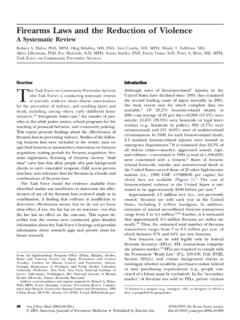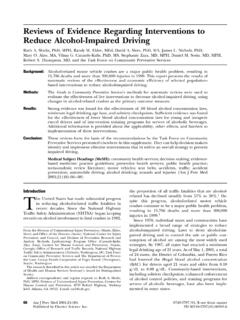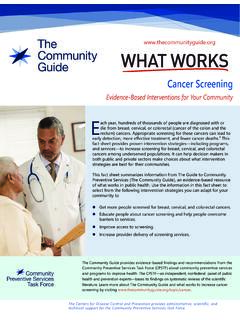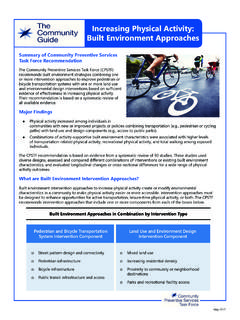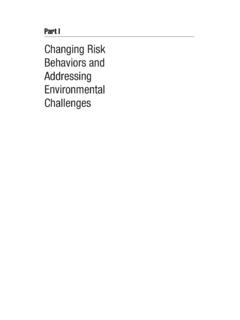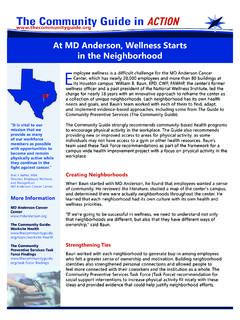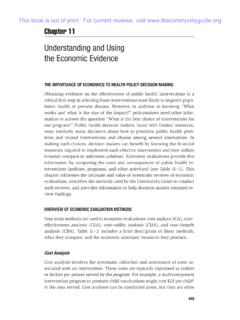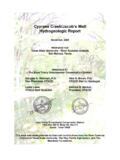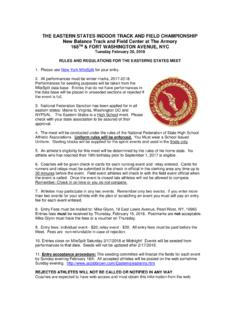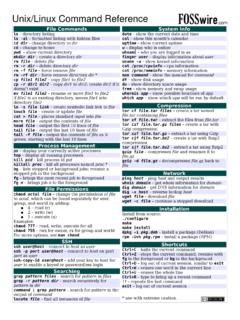Transcription of Economics of Self-Measured Blood Pressure Monitoring A ...
1 community guide systematic REVIEWE conomics of Self-Measured Blood PressureMonitoring: a community guide systematic ReviewVerughese jacob , PhD, MPH,1 Sajal K. Chattopadhyay, PhD,1 Krista K. Proia, MPH,2 David P. Hopkins, MD, MPH,1 Jeffrey Reynolds, MPH,1 Anilkrishna B. Thota, MBBS, MPH,1 Christopher D. Jones, PhD, MSW,3 Daniel T. Lackland, DrPH,4 Kimberly J. Rask, MD, PhD,5 Nicolaas P. Pronk, PhD, MA,6,7 John M. Clymer, BA,8 Ron Z. Goetzel, PhD, MA9,10and the community Preventive Services Task ForceContext:The health and economic burden of hypertension, a major risk factor for cardiovasculardisease, is substantial. This systematic review evaluated the economic evidence of self -measuredblood Pressure (SMBP) Monitoring interventions to control acquisition:The literature search from database inception to March 2015 identified 22studies for inclusion with three types of interventions: SMBP used alone, SMBP with additionalsupport, and SMBP within team-based care (TBC).
2 Two formulae were used to convert reductions insystolic BP (SBP) to quality-adjusted life years (QALYs) to produce cost per QALY saved. Allanalyses were conducted in 2015, with estimates adjusted to 2014 synthesis:Median costs of intervention were $60 and $174 per person for SMBP alone andSMBP with additional support, respectively, and $732 per person per year for SMBP within TBC. SMBP alone and SMBP with additional support reduced healthcare cost per person per year from outpatientvisits and medication (medians $148 and$3, respectively; median follow-up, 12 13 months). SMBP within TBC exhibited an increase in healthcare cost (median, $369 per person per year; median follow-up, 18 months).
3 SMBP alone varied from cost saving to a maximum cost of $144,000 per QALY saved,with two studies reporting an increase in SBP. The two translated median costs per QALY saved were$2,800 and $4,000 for SMBP with additional support and $7,500 and $10,800 for SMBP within :SMBP Monitoring interventions with additional support or within TBC are costeffective. Cost effectiveness of SMBP used alone could not be J Prev Med 2017;53(3):e105 e113. Published by Elsevier Inc. on behalf of American Journal of PreventiveMedicineCONTEXTHigh Blood Pressure (BP) is an important riskfactor for cardiovascular disease (CVD) andstroke in the , accounting annually for morethan $193 billion in medical care and about $123 billionin lost productivity in 2011 control of highBP with medication and other treatments can preventand avert a substantial part of this societal burden,2evenFrom the1 community guide Branch, Division of Public Health Informa-tion Dissemination, Center for Surveillance, Epidemiology, and LaboratoryServices, Centers for Disease Control and Prevention (CDC), Atlanta,Georgia.
4 2 Division of Diabetes Translation, National Center for ChronicDisease Prevention and Health Promotion, CDC, Atlanta, Georgia;3 Division for Heart Disease and Stroke Prevention, Office of Noncommu-nicable Diseases, Injury, and Environmental Health, CDC, Atlanta,Georgia;4 Medical University of South Carolina, Charleston, SouthCarolina;5 Emory University, Alliant Health Solutions, Atlanta, Georgia;6 HealthPartners Institute, Minneapolis, Minnesota;7 Harvard ChanSchool of Public Health, Boston, Massachusetts;8 National Forum for HeartDisease and Stroke Prevention, Washington, District of Columbia;9 JohnsHopkins Bloomberg School of Public Health, Baltimore, Maryland; and10 Truven Health Analytics, Bethesda, MarylandNames and aff liations of Task Force members are available correspondence to: Verughese jacob , PhD, MPH, CommunityGuide Branch, CDC, 1600 Clifton Road, Mailstop E69, Atlanta GA : by Elsevier Inc.
5 On behalf of American Journal of Preventive MedicineAm J Prev Med 2017;53(3):e105 e113e105as costs are projected to increase with hypertension-related outcomes, such as stroke, in a growing and example, hypertension control effortshave contributed to the decline in stroke mortality becausedistributions of population systolic BP (SBP) have Blood Pressure (SMBP) monitoringinterventions use BP Monitoring devices operated bypatients to improve the management of high BP. Thisprocess provides clinicians with accurate and frequentmeasurements, increases patient engagement in their owncare, and prompts patients to adopt healthful recent systematic review5,6conducted for the Agency forHealthcare Research and Quality showed that SMBP Monitoring interventions, typically in the home, wereeffective in improving BP outcomes in patients with highBP, reducing SBP by mmHg and diastolic BP.
6 There has been no publishedreview of the Economics of these objective of the present paper is to assess the costand economic benefit of SMBP Monitoring interventionsbased on a systematic review of the ACQUISITIONC oncepts and MethodsThis study was conducted using community guide methods forsystematic economic reviews, available A review team (the team)was constituted, including subject matter experts on CVD andhypertension from various agencies, organizations, and academicinstitutions together with experts in systematic reviews from theCommunity guide Branch at the Centers for Disease Control andPrevention. The team worked under the oversight of the Com-munity Preventive Services Task with SMBP Monitoring involve use of personal BPmeasurement devices to improve the treatment of high are trained to use these devices in familiar settings, suchas their homes.
7 Readings are shared with their healthcare providersduring clinic visits, by telephone, or electronically, and aremonitored and used in treatment decisions to improve BP interventions also may involve support such as medicationand lifestyle counseling, patient education for self -management,and telephone or web-based SMBP interventions often are delivered within team-basedcare (TBC) for BP control, in which primary care providers andpatients work together with other providers to improve theefficiency of care delivery and self -management support for novel feature of the present review is the categorization ofSMBP Monitoring interventions into interventions implementingSMBP alone, SMBP with additional support, and SMBP withinTBC.
8 Distinction is drawn between additional support and team-based care because the latter is far more comprehensive andresource intensive than SMBP interventions that add web- orphone-enabled patient support. Further, SMBP alone and SMBP with additional support are both capital intensive, whereas SMBP within TBC is more labor the focus of the Agency for Healthcare Research andQuality effectiveness review5,6of SMBP interventions was ontreatment and management of high BP, this economic review alsorecognizes the diagnostic function of home BP monitors becauseidentification of white coat hypertension and masked hyper-tensiona,8 ,9in a population can have substantial implications forhealthcare resource 1depicts the intervention, the population, and transi-tions in health status ascribed to the intervention (InterventionEffectiveness)
9 , below which appear associated resource use andFigure of SMBP Monitoring interventions to improve BP , Blood Pressure ; CVD, cardiovascular disease; LY, life years; QALY, quality-adjusted life years; SMBP, Self-Measured Blood Pressure ; TBC, team-based with isolated high Blood Pressure in the medical setting and in thepresence of medical personnel are said to have white coat hypertension. Patients with controlled Blood Pressure measured in the clinic anduncontrolled Blood Pressure when measured outside the clinic are said tohave masked hypertension. jacob et al / Am J Prev Med 2017;53(3):e105 benefits (Economic Outcomes). This economic reviewtakes a societal perspective, which means costs and economicbenefits are aggregated regardless of who pays and who following research questions are considered based on theeconomic effects of the intervention illustrated inFigure 1: What is the cost to implement the intervention?
10 What is the effect of the intervention on healthcare cost? What is the effect of the intervention on productivity of patientsat their workplaces? What is the net economic benefit of the intervention? What is the cost effectiveness of the intervention? In particular,what is cost per quality-adjusted life year (QALY) saved?The target population of the interventions for this review arepatients diagnosed with hypertension in primary care. Studiesfocused on patients with established CVD, gestational hyper-tension, and those receiving dialysis were excluded as were thosefocused on patients with illnesses that prevent them from using thehome BP devices. Only published studies of interventions imple-mented in high-income countries were included.
